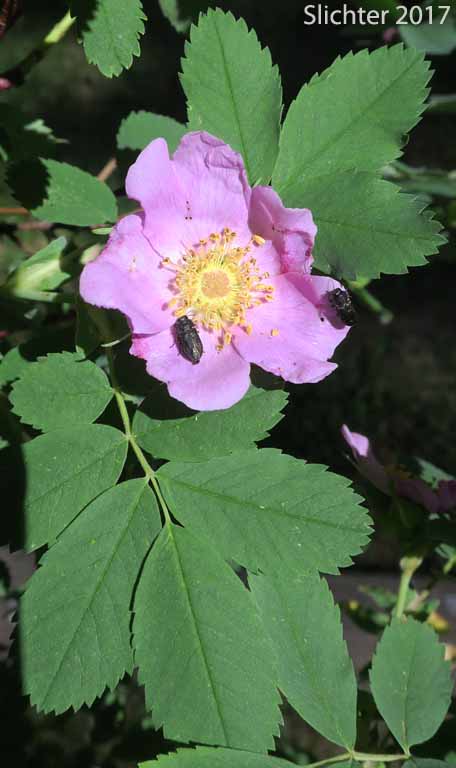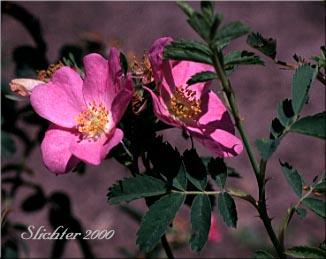Pearhip Rose, Wood's Rose
Rosa woodsii var. ultramontana
Synonyms: Rosa arizonica, Rosa arizonica var. granulifera, Rosa covillei, Rosa macounii, Rosa lapwaiensis, Rosa pecosensis, Rosa ultramontana, Rosa woodsii ssp. ultramontana, Rosa woodsii var. arizonica, Rosa woodsii var. granulifera, Rosa woodsii var. woodsii
 -
- 
A close-up of a flower of pearhip rose as seenat left from atop Burch Mt., several miles north of Wenatchee, WA.........June
6, 2009. The photo at right shows a sideview of the inflorescence of pearhip rose as seen at the entrance to the Little Spokane State Fish Hatchery, Spokane County, WA.......June 26, 2022. Pearhip rose has clusters of flowers while the similar Nootka rose has single flowers.
Characteristics:
Pearhip rose is a woody shrub with erect stems from 1-2 meters
high. The stems bear strong, straight or slightly curved prickles below the
stipules or bases of the petioles. The leaves are alternate on the stems and
have 5-9 pinnately compound leaflets. The leaflets are ovate, obovate, or elliptic
with toothed margins. Individual teeth may be greater than 1 mm in length and
are only gland tipped in variety woodsii. The leaflets are up to 5 cm
long and 2.5 cm wide.
The inflorescence is a small cluster or cyme of 3-5 flowers
at the tips of the stems. The pinkish to rose-colored flowers are small and
about 2.5-5 cm across with 5 petals. The petals are 1.5-2.5 cm long. The rose
hips are globose, ellipsoid, or pear-shaped, and 6-12 mm long and wide. The
hips are red and have sepals which persist at the tip of the fruit.
It may be identified from Rosa nutkana
due to the smaller, clustered flowers.
Habitat:
Pearhip rose is found in moist open ground and open woods in
the east Columbia River Gorge, and elsewhere in its range, prefers warm, dry
sites, often mixed with Nootka rose..
Range:
Pearhip rose is found east of the Cascade summits in Washington
and Oregon and south to southern California. It is found east to Minnesota,
Wisconsin, Missouri and Texas.

Mature fruits of pearhip rose as seen in open forests on Missoula Flood sandbars between Five Mile and the Little Spokane River, Spokane County, WA.......November 10, 2018. The flowers and fruits are usually found in clusters. Occasionally, plants will have gland-tipped hairs on the pedicels, as seen here.
 -
-  -
- 
Pearhip rose blooming at Ochoco Forest Camp (near the old ranger station on Ochoco Creek), Ochoco National Forest...........June 26, 2017.
 -
- 
A close-up of a thorns and flower of pearhip rose as seen from atop Burch Mt., several miles north of Wenatchee, WA........June
6, 2009.
 -
- 
Additional close-up photos of pearhip rose as seen along the valley trail about one-half mile uphill and northwest of the Painted Rocks trailhead, Little Spokane River Natural Area.........July 5, 2011.
 -
- 
Pearhip rose as seen along the trail at Douglas Creek South, Douglas County, Washington........June 3, 2013.

Pearhip rose from Steptoe Butte State Park, eastern Washington.......June
27, 1998.

Paul Slichter













